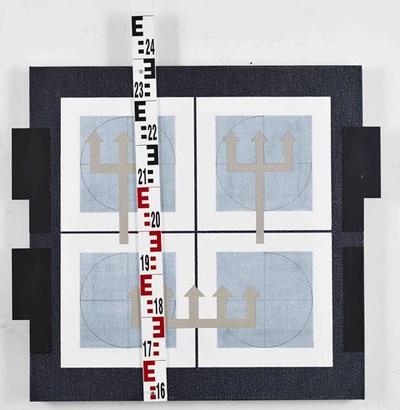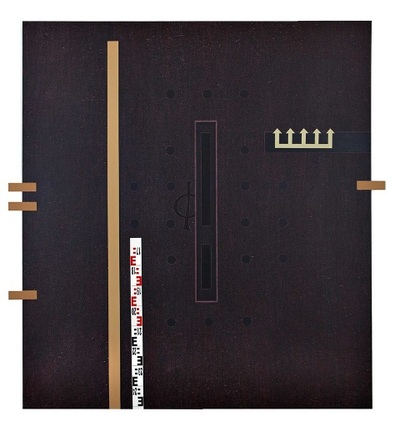Halil Akdeniz | Selected Bio Texts
Time Squeezed İnto Cultural Realms İn The Art of Halil Akdeniz
Perceiving the antinomies generated over time by cultural phenomena, and re-expressing them in terms of present-day values, is only possible, one would think, after a detailed act of research/knowing and discovery. Thus obtained, examples with intercultural or historical referents are cited, in the words of Anne Game, to render modern society meaningful. In this process, the artist has need of these “evidential signs”, with their roots in history and culture, in order to describe the present, participate in the multiplicity of meanings that characterize modern-day society, and express his uneasiness with the established order. For the artist, by selecting these data, not only brings together cultural strata, he at the same time alludes to refraction and diffraction in the universe of creation.
Halil Akdeniz bases his approach to art on just this sort of conception, and in his paintings unitary elements comprising a variety of cultural codes may be juxtaposed on a heterogenous surface which equates with different slices of time. In a way, titles pointing to "vanished and heaped time" reflect the intensity of movement between the past and present quietly, but with tension, in the form of chosen signs. Positioned hierarchically on the canvas, these images have a power, one that could almost be put to the test, of carrying out a socio-cultural analysis. And the picture surface where this operation is effected directly confronts the viewer with signs that sometimes have shock value. Actually, this system of cultural language and signs that stands casually in our public spaces, with no hint of murkiness, and is part and parcel of our concept of belonging. In fact, this type of image product, apart from being a legacy in terms of the language they create, can also become a global "provocative sign" through the layers of meaning they generate.
Here it behooves us to explore the most recent works by Halil Akdeniz, which offer a new perspective in his artistic stance, being made up of "a single image on a single canvas" as they objectify the picture surface and present the aspect of a fetish. For the sake of creating a temporal complexity, surfaces relating to the past are placed side by side, either recognizing one another or entirely dissipant in their heterotopic space. In other words, these sign/surfaces, treated with a compositional logic, sometimes disturb each other due to a compulsory randomness, and sometimes provide clues to the viewer regarding the expatiation of an enriched vocabulary of images.
Similarly, Akdeniz`s now existential concept of the surface slips free of the canvas cloth –especially in his most recent work – to come up once again transformed into a tangible signifier. Blank space has become a palpable substance, and at times the sign/surfaces (fragments) added to the blank spaces end by carrying us back to the slices of time to which they belong. The void of the time in which we find ourselves is now there, which is to say that the picture now embraces future time as well and, spilling out from the bounded voids of the canvas, joins up with the moment we are experiencing. Thus an endless separative-combinative system enriched by new visual signs prompts us to reflect, via the canvas, on space-time concepts related to the future.
A propos, in Akdeniz`s latest work the canvases, objects which exist as unitary structures, have a tendency to extend beyond the frame, and it is by now a matter of composition which encompasses limitless possibilities thanks to a new process of adding and splitting. One may further say that the asymmetry which guides this approach has become a major principle in building up the work, to such an extent that it would be impossible to remove any one part of the canvas. The surfaces, curtailed in a mutual space where they then meet anew, are nothing more nor less than the reflection in form of a "temporal splitting", if one may be permitted that phrase.
Meanwhile the meticulously-executed texture-surfaces which feature predominately in the art of Halil Akdeniz have a fluidity and comprehensiveness which probe the depths of the viewer. The spontaneous phenomena which exist on these surfaces are left, for the sake of creating "partial space", without being disrupted. The color used for this empty space, at times becoming green and at times the color of granite, is always both within and beyond a mysterious atmosphere. Clearly, once this sometimes differently-colored undersurface-void-space manifests itself it is on the job, prepared in all its ordinariness to bear plastic elements. It might even be said that the spell cast by Akdeniz`s paintings lies here, in this texture-surface which has the quality of an object and in fact has become a characteristic of identity.
As for the "liberated void" which wanders on these same surfaces, on the one hand it points to the intensity of the signified, while on the other hand rendering genuine the substantiality of the work. And in one sense the first stages of an impossible compromise with the viewer are generated here. In this genre of ratiocination, the records of cultural analysis are fragmentarily manifested in the void while at the same time a realm of meaning comes into play whose borders are drawn although it is boundless – precisely like the sign/images which primarily give these proffered works their identity, the F, mira or letters from the Cyrillic alphabet...
Actually what one witnesses in the paintings of Halil Akdeniz, conveyed by signs deriving from varying cultural periods, is the simultaneous exploration on surface fragments of such concepts as culture, death and the genuine. Ultimately, however, cultural systems are dismantled as the artist works to reestablish. Signs are reiterated, discarded and reclaimed to create a "possible realm of the infinite", while at the same time canvas units are rejected and added to indulge a playful (and experimental) pleaure in the act of disassembly/building.
To sum up, time squeezed into cultural realms, and a decentralized space, reconstruct themselves each time on the abstract plane for the sake of perpetuating a cultural legacy. In any case, linguistic signs whose function is to create a synthesis between the past and present complement their impact and power, metaphorically, in the presence of the concepts of equilibrium and pleasure. Just as when Adorno, comparing the text to a spiderweb, says that "metaphors which stick to the web are like the prey which nourishes it", in Halil Akdeniz, this sign-language system becomes the essential prey of the paintings to offer up a new, particular and subjective interpretation regarding society’s cultural memory. In this way, signs torn from infinitely continuous time, in their new space now dominate an entire surface and now slip free of present-day antinomies to manage a dialogue with the everyday.
In the end, when viewing these pictures we surrender ourselves to the taut pleasure of the newly created fields of attraction that arise from the combining of extratemporal signs with the potency of void. Just as with the silence of a universal harmony, we meet up with a design and concept that envelop and draw us in. What’s more, this ritual created in the minimal universe is by now dedicated to generating the obligatory stages of content (the concept). With these forthrightly pursued cultural and temporal relationships, Halil Akdeniz is also, in a way, asking just what the new and everyday might be in our time. And at any rate, the "tools of analysis", consisting of visual elements and insistently pursued on Akdeniz’s canvas surfaces – are they not, after all, evidence of potential life content?
Gülay Yaşayanlar
Perceiving the antinomies generated over time by cultural phenomena, and re-expressing them in terms of present-day values, is only possible, one would think, after a detailed act of research/knowing and discovery. Thus obtained, examples with intercultural or historical referents are cited, in the words of Anne Game, to render modern society meaningful. In this process, the artist has need of these “evidential signs”, with their roots in history and culture, in order to describe the present, participate in the multiplicity of meanings that characterize modern-day society, and express his uneasiness with the established order. For the artist, by selecting these data, not only brings together cultural strata, he at the same time alludes to refraction and diffraction in the universe of creation.
Halil Akdeniz bases his approach to art on just this sort of conception, and in his paintings unitary elements comprising a variety of cultural codes may be juxtaposed on a heterogenous surface which equates with different slices of time. In a way, titles pointing to "vanished and heaped time" reflect the intensity of movement between the past and present quietly, but with tension, in the form of chosen signs. Positioned hierarchically on the canvas, these images have a power, one that could almost be put to the test, of carrying out a socio-cultural analysis. And the picture surface where this operation is effected directly confronts the viewer with signs that sometimes have shock value. Actually, this system of cultural language and signs that stands casually in our public spaces, with no hint of murkiness, and is part and parcel of our concept of belonging. In fact, this type of image product, apart from being a legacy in terms of the language they create, can also become a global "provocative sign" through the layers of meaning they generate.
Here it behooves us to explore the most recent works by Halil Akdeniz, which offer a new perspective in his artistic stance, being made up of "a single image on a single canvas" as they objectify the picture surface and present the aspect of a fetish. For the sake of creating a temporal complexity, surfaces relating to the past are placed side by side, either recognizing one another or entirely dissipant in their heterotopic space. In other words, these sign/surfaces, treated with a compositional logic, sometimes disturb each other due to a compulsory randomness, and sometimes provide clues to the viewer regarding the expatiation of an enriched vocabulary of images.
Similarly, Akdeniz`s now existential concept of the surface slips free of the canvas cloth –especially in his most recent work – to come up once again transformed into a tangible signifier. Blank space has become a palpable substance, and at times the sign/surfaces (fragments) added to the blank spaces end by carrying us back to the slices of time to which they belong. The void of the time in which we find ourselves is now there, which is to say that the picture now embraces future time as well and, spilling out from the bounded voids of the canvas, joins up with the moment we are experiencing. Thus an endless separative-combinative system enriched by new visual signs prompts us to reflect, via the canvas, on space-time concepts related to the future.
A propos, in Akdeniz`s latest work the canvases, objects which exist as unitary structures, have a tendency to extend beyond the frame, and it is by now a matter of composition which encompasses limitless possibilities thanks to a new process of adding and splitting. One may further say that the asymmetry which guides this approach has become a major principle in building up the work, to such an extent that it would be impossible to remove any one part of the canvas. The surfaces, curtailed in a mutual space where they then meet anew, are nothing more nor less than the reflection in form of a "temporal splitting", if one may be permitted that phrase.
Meanwhile the meticulously-executed texture-surfaces which feature predominately in the art of Halil Akdeniz have a fluidity and comprehensiveness which probe the depths of the viewer. The spontaneous phenomena which exist on these surfaces are left, for the sake of creating "partial space", without being disrupted. The color used for this empty space, at times becoming green and at times the color of granite, is always both within and beyond a mysterious atmosphere. Clearly, once this sometimes differently-colored undersurface-void-space manifests itself it is on the job, prepared in all its ordinariness to bear plastic elements. It might even be said that the spell cast by Akdeniz`s paintings lies here, in this texture-surface which has the quality of an object and in fact has become a characteristic of identity.
As for the "liberated void" which wanders on these same surfaces, on the one hand it points to the intensity of the signified, while on the other hand rendering genuine the substantiality of the work. And in one sense the first stages of an impossible compromise with the viewer are generated here. In this genre of ratiocination, the records of cultural analysis are fragmentarily manifested in the void while at the same time a realm of meaning comes into play whose borders are drawn although it is boundless – precisely like the sign/images which primarily give these proffered works their identity, the F, mira or letters from the Cyrillic alphabet...
Actually what one witnesses in the paintings of Halil Akdeniz, conveyed by signs deriving from varying cultural periods, is the simultaneous exploration on surface fragments of such concepts as culture, death and the genuine. Ultimately, however, cultural systems are dismantled as the artist works to reestablish. Signs are reiterated, discarded and reclaimed to create a "possible realm of the infinite", while at the same time canvas units are rejected and added to indulge a playful (and experimental) pleaure in the act of disassembly/building.
To sum up, time squeezed into cultural realms, and a decentralized space, reconstruct themselves each time on the abstract plane for the sake of perpetuating a cultural legacy. In any case, linguistic signs whose function is to create a synthesis between the past and present complement their impact and power, metaphorically, in the presence of the concepts of equilibrium and pleasure. Just as when Adorno, comparing the text to a spiderweb, says that "metaphors which stick to the web are like the prey which nourishes it", in Halil Akdeniz, this sign-language system becomes the essential prey of the paintings to offer up a new, particular and subjective interpretation regarding society’s cultural memory. In this way, signs torn from infinitely continuous time, in their new space now dominate an entire surface and now slip free of present-day antinomies to manage a dialogue with the everyday.
In the end, when viewing these pictures we surrender ourselves to the taut pleasure of the newly created fields of attraction that arise from the combining of extratemporal signs with the potency of void. Just as with the silence of a universal harmony, we meet up with a design and concept that envelop and draw us in. What’s more, this ritual created in the minimal universe is by now dedicated to generating the obligatory stages of content (the concept). With these forthrightly pursued cultural and temporal relationships, Halil Akdeniz is also, in a way, asking just what the new and everyday might be in our time. And at any rate, the "tools of analysis", consisting of visual elements and insistently pursued on Akdeniz’s canvas surfaces – are they not, after all, evidence of potential life content?
Gülay Yaşayanlar



